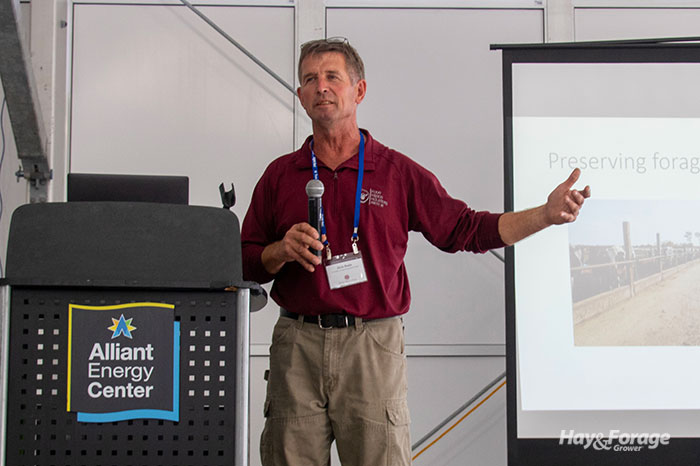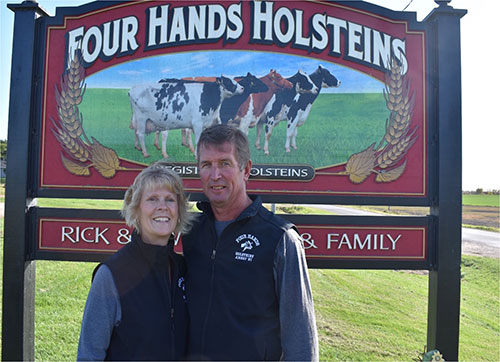Forage is key at Four Hands Holsteins |
| By Amber Friedrichsen, Associate Editor |
|
|
 Some farmers grow up milking cows on a multi-generational operation, and others are the first in their family to establish a dairy. That said, no matter how one’s story begins, a common theme among many modern producers is their transition from dairy to another aspect of agriculture. Rick Dado is one exception. Dado and his wife, Gwen, own Four Hands Holsteins Inc., near Amery, Wis. The couple and their four children — the four hands — established the operation in 2007 after purchasing it from Gwen’s family. Before becoming a full-time dairy farmer, Dado began his career in forage research and ruminant nutrition. His experiences working in education and in the industry have been invaluable to maintaining high-producing dairy cattle and managing 1,500 acres of forage.  Rick and Gwen Dado Dado grows about 500 acres of alfalfa and 400 acres of brown midrib (BMR) corn for silage. The remaining acreage accounts for conventional corn, grain crops, and grass hayfields. Forage makes up about 60% of the ration formulated for lactating cows on a dry matter basis, which is why his overall goal is to grow large quantities of high-quality forage and preserve feed value as much as possible from harvest until feedout. To be realistic, though, Dado abides by the 80:20 rule. He aims to hit 80% of his targets for certain aspects of forage and livestock production and anticipates things may not go to plan the other 20% of the time. This not only alleviates the pressure of striving for perfection, but it makes it easier to overcome issues by accepting that mistakes are bound to happen. “We have benchmarks for parameters like forage quality, milk production, pregnancy rates, and herd turnover. Those are very important things that contribute to our return on investment, but we can’t be perfect in all of those areas. It would cost too much,” Dado explained. “If I can hit that 80% in my forage quality or in conception rates, I think I am doing pretty good.” Crop rotations Preparation for the upcoming growing season starts in the fall when Dado selects corn hybrids. He currently grows 106-day BMR corn for silage, which is a relatively late maturity for his location. “The reason we choose that maturity is because we are the last of four farms to be harvested by our custom harvester. When you’re the last of four farms for corn silage, you better have something that holds on,” he asserted. “There was a time when we didn’t have [late-maturing corn] and it always got too dry.” Also in the fall, Dado spreads manure on cornfields that will be seeded to alfalfa the following spring. “We have found that the young alfalfa seedlings really respond to manure applications prior to seeding,” he said. “It has also been very useful to work up this ground in the fall so when you come back in the spring, the soil is so mellow that it dries up and the top 2 inches are perfect for an alfalfa base and germination.” Alfalfa stands last two to three years after the seeding year before they are terminated in the fall and later rotated to corn. Sticking to this swift rotation helps ensure stands are healthy and plant populations remain high. It also creates a faster return rate of nitrogen credits from alfalfa to corn than a longer rotation would allow. Hiccups in harvest Waiting for a custom harvester to chop is not ideal, and sometimes comes at the cost of alfalfa quality. One of Dado’s biggest challenges is not getting forage cut soon enough, especially during first cutting. Even so, he tries to maintain harvest efficiency when schedules get delayed to capture as much feed value as possible. “If I had my preference, our goal would be alfalfa with at least 170 RFQ at 60% moisture,” Dado said. “Matching the pace of the mowers, mergers, and choppers is so critical. You have to know how dense that stand is, is the sun shining or is it cloudy, and you have to make sure the mower stays ahead of the merger so it is chopped at the right moisture.” Alfalfa is typically cut four times a year and every cutting is stored in the same bunker, so Dado is constantly moving tires to cover and uncover the haylage pile. Although this requires more labor, it saves more space and resources than if he were to store alfalfa in multiple locations. During feedout, Dado removes about 9 inches of forage across the width of the 90-foot pile per day with a grapple bucket. Doing so leaves a relatively smooth face, which reduces the amount of spoilage that occurs from exposure to oxygen and moisture. Even so, Dado considers variations throughout the pile when he formulates rations and allocates the highest quality haylage to lactating cows. While Dado is willing to accept errors in forage production, he is not willing to compromise milk production or cow care. Cattle currently average about 99 pounds of milk per day, and the herd averages 4.2% milkfat and 3.3% protein. He believes a major component of hitting these numbers is the way animals are housed on the farm. “Some of our barns are newer, some are older, but they are all sand freestalls, which I think is absolutely critical” he stated. “If you’re going to take advantage of high forage quality, you have to have a comfortable place for your cows.” With that said, Dado believes there is no silver bullet for dairy management. By applying what he learned earlier in his career, he has developed strategies to meet his specific crop and livestock needs. “There are as many ways to do this as there are farms,” Dado said about running a dairy. “The bottom line is to try and control what you can control.” |
